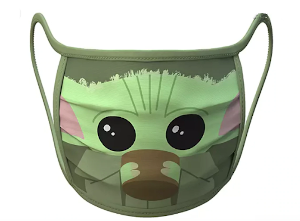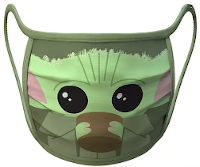— from Dr. Mark Fishaut and Dr. Frank James —

In many places, people are wearing masks when they’re in public because of coronavirus (COVID-19). It’s an important way to help slow the spread of the virus.
At first, it was mostly doctors, nurses, and others in health care settings who wore masks. But now, as other people wear them, more and more kids are seeing something they’re not used to seeing. For them, it can be strange or a little scary, especially if they need to put on masks, too.
Most kids can feel comfortable seeing people in masks, as long as adults:
- Use simple words to explain why people are wearing masks.
- Give kids time to look, watch, and get used to what’s new.
- Answer kids’ questions.
- Give support.
Some toddlers and young children may feel uneasy about masks. They
may need extra support and comfort from parents. Parents also can help
kids understand why they might need to wear a mask, and make them
more comfortable and even fun to wear.
How Do Kids React to Masks?
How kids react to seeing masks partly depends on their age. Older kids
might not react much at all. To them, masks might seem like no big deal.
Most are able to adjust pretty quickly.
Some kids may even be eager to wear a mask. They might embrace their
new look as a medical superhero.
But for babies, toddlers, and young kids, seeing people in masks might
take some getting used to. At first, they may feel cautious. They may need
a few minutes to look and watch. That can help them get used to what’s
new. They may need a parent to gently say, “It’s OK.” That can help them
relax.
Some babies, toddlers, and young kids may feel upset or afraid. They
might cry, hide their face, or cling to a parent. Soothing words, comfort, and the safety of a parent’s lap can help calm them.
Why Do Some Young Kids Feel Scared of Masks?
Masks hide part of a person’s face. Young children rely on faces. From the
time they are babies, young children look at faces for the signals they need
to feel safe.
When faces are partly hidden by masks, kids can’t see the friendly smile or
familiar look that usually puts them at ease. When kids can’t see the
person’s whole face, it’s harder to feel safe. It’s natural to feel scared.
But slowly and gently, parents can help kids feel more comfortable. Even
very young kids can learn that something that seemed too scary at first is
not so scary after all.
How Can Parents Help Kids Wear a Mask?
Cloth face coverings (or a face mask, if you have one) on adults and kids
over 2 years old can help slow the spread of the virus. Here are some
ways to help kids wear masks when you go out:
- Help kids get used to masks. As much as you can, give kids time to practice wearing their masks before they might need to wear one outside of your home. Teach them how to put them on and take them off.
- Encourage kids to decorate their mask. This might help them feel a sense of ownership and control over the situation. A personal touch can help make it more of a normal part of their routine, and make it more likely they’ll want to wear their mask. Depending on the type of mask, kids can draw on it with markers or put stickers on it.
- Make them together. If you make face coverings at home, let older kids help you. There are no-sew masks that are easy to make, often with materials you probably already have (T-shirts, bandannas, etc.).
If you sew masks, maybe kids can select the fabric or patterns for the
masks they’ll wear.
- Help make it fun. With younger kids, introduce a sense of play. Kids can pretend to be a doctor or nurse while wearing their masks. They might want to use a doctor kit and “take care” of a stuffed animal or doll.
- Have a few masks handy while kids play. This lets them use their imagination about how to use them during playtime. It also helps make masks a more normal part of their everyday world. You can ask your child to put a mask on a stuffed animal, and then ask follow-up questions about why the stuffed animal is wearing the mask.
- Depending on your child’s response, you can clear up any confusion and offer reassurance.
How Can I Help My Child During Medical Visits?
For older kids:
- Tell kids what to expect and why. Mention masking before the visit, if you can. For kids old enough to understand, you might say, “I think we’ll see doctors and nurses wearing their masks today. It’s a new thing they’re doing to stop germs.” Explain it in a way that seems matter of fact and calm.
- If you will wear masks, tell your child, “We might get to wear masks too. We want to stop germs too, right?” Knowing what to expect helps kids of all ages feel prepared and more at ease
- Explain the upside. Be honest, but focus on the good that masks can do, rather than the bad things a virus can do. For example, you might say, “Because of the coronavirus that’s going around, everyone is doing extra things to stop its germs from spreading. Wearing masks is one of the ways we can stop the virus.”
- Let kids show what they know. Invite school-age kids to tell you the other things you already do as a family to stop germs. For example, prompt kids to say or show how they wash their hands. Give them a word of praise to help them feel proud and capable. When kids know there are things they can do, they feel confident and more at ease.
For younger kids who feel upset by masks:
- Accept how they react. Know that it’s normal for young kids to react with caution to things they don’t expect, understand, or feel familiar
- with. Let them take their time to warm up to what’s new.
- Comfort them. Kids will look to you to soothe and support them. Let them sit on your lap. Tell them, “You’re OK, I’m here.” When you help them feel safe, they can start to adjust to what’s different or new. They can start to feel less cautious and more curious.
- Be playful and show love. If the moment seems right, find a way to be playful with your child. While you’re still at the medical visit, is there a way to help your child laugh, smile, or giggle? Laughing is relaxing. And a few sweet moments help balance out the stressful ones.
After the visit:
If your child seemed upset, worried, or stressed during the visit, doing
these things can help:
- Talk about it. After the visit, it can help to talk with your child. You might say, “Everybody looked different today wearing those masks, didn’t they?”
- Then listen. Let your child tell you what it was like for them. Find ways to praise your child. “It wasn’t easy. You did great. I’m proud of you.” Call out a bright spot. “I’m glad we got to wave to the nurse who took care of you last time. I think it made him feel happy too.”
- Invite your child to draw or play about it. Together, you could draw pictures of people wearing masks and not wearing masks. Or make a play mask and let a doll or stuffed animal try it on.
Play and drawing can help kids work out what they saw and felt. They are a way to rehash and rehearse. And that helps kids feel a little more prepared for next time.
**If you are reading theOrcasonian for free, thank your fellow islanders. If you would like to support theOrcasonian CLICK HERE to set your modestly-priced, voluntary subscription. Otherwise, no worries; we’re happy to share with you.**









As many have figured out by now, wearing a mask does not protect the wearer all that much more, unless the mask is sealed to the face.
Wearing a mask is protecting the other people around you from your coughing or sneezing.
I encourage you all to question the official narrative here, the public is rarely told the truth about what is going on.
Be Peace,
Stand In Your Truth,
Be Blessed.
WE ARE ALL ONE